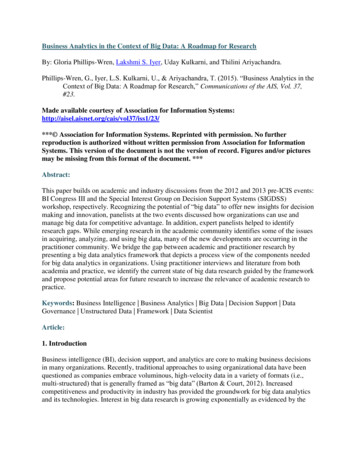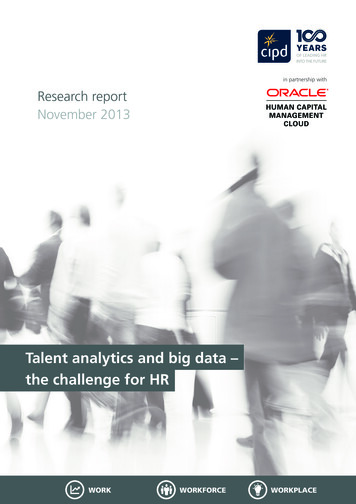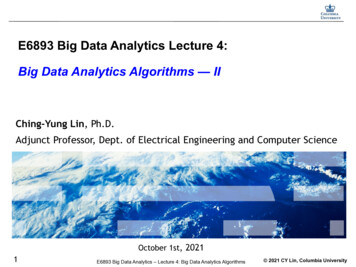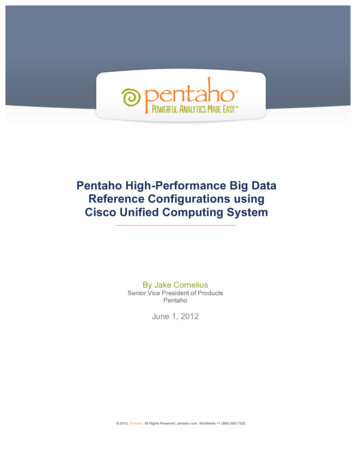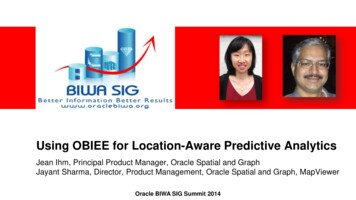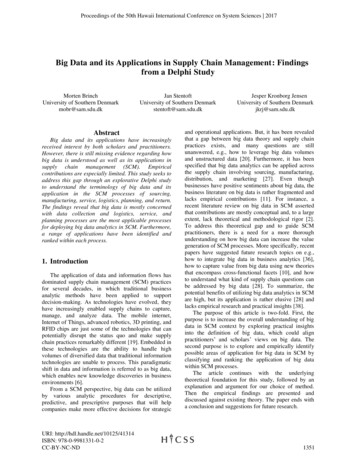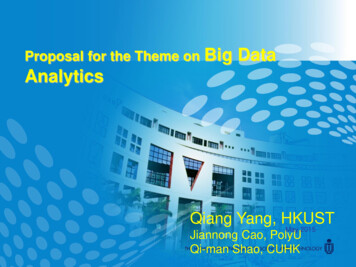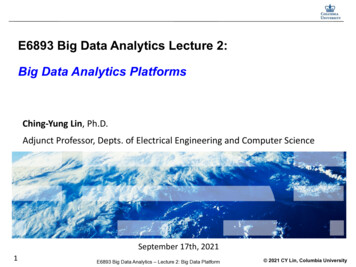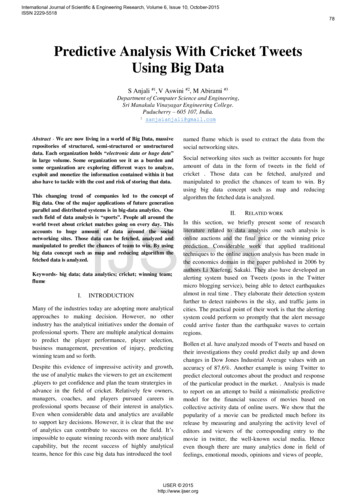
Transcription
Big Data Analytics: A Literature ReviewPerspectiveSarah Al-ShiakhliInformation Security, master's level (120 credits)2019Luleå University of TechnologyDepartment of Computer Science, Electrical and Space Engineering
AbstractBig data is currently a buzzword in both academia and industry, with the term being used todescribe a broad domain of concepts, ranging from extracting data from outside sources, storingand managing it, to processing such data with analytical techniques and tools.This thesis work thus aims to provide a review of current big data analytics concepts in an attemptto highlight big data analytics’ importance to decision making.Due to the rapid increase in interest in big data and its importance to academia, industry, andsociety, solutions to handling data and extracting knowledge from datasets need to be developedand provided with some urgency to allow decision makers to gain valuable insights from the variedand rapidly changing data they now have access to. Many companies are using big data analyticsto analyse the massive quantities of data they have, with the results influencing their decisionmaking. Many studies have shown the benefits of using big data in various sectors, and in thisthesis work, various big data analytical techniques and tools are discussed to allow analysis of theapplication of big data analytics in several different domains.Keywords: Literature review, big data, big data analytics and tools, decision making, big dataapplications.
Sarah Al-ShiakhliContentsAbstract . iContents . ii1.Introduction . 12.Research Question . 23.Research Method . 34.Scope delimitation and risks . 75.What is “big data”? . 86.Big data characteristics . 157.Big data analytics (BDA): tools and methods . 187.1.Big data storage and management . 187.2.Big data analytics processing . 197.3.Big data analytics . 207.1.1.Supervised techniques . 227.1.2.Un-supervised techniques . 247.1.3.Semi-supervised techniques . 247.1.4.Reinforcement learning (RL) . 257.4.Analytics techniques . 267.5.Big data platforms and tools . 308.Big Data Analytics and Decision Making . 349.Big data analytics challenges . 379.1.Data Security issues . 379.2.Data privacy issues . 399.3.Data storage, data capture and quality of data . 399.4.Challenges in data analysis and visualisation . 4010.Big data analytics applications. 4210.1.Healthcare . 4310.2.Banking . 4310.3.Retail . 4410.4.Telecommunications . 4511.Implications of research . 4512.Conclusion and Future Research . 4613.References . 47ii
Sarah Al-Shiakhli1. IntroductionBig data refers to datasets which are both large in size and high in variety and velocity of data,characteristics which make it difficult for them to be handled using traditional techniques and tools(Constantiou, I.D. and Kallinikos, J., 2015). This has generated a need for research into andprovision of solutions to handle and extract knowledge from such datasets. Due to the largequantities of data involved, multiple technologies and frameworks have been created in order toprovide additional storage capacity and real-time analysis. Many models, programs, software,hardware, and technologies have thus been designed specifically for extracting knowledge frombig data (Oussous et al., 2018), as the extensive but rapidly changing data from daily transactions,customer interactions, and social networks has the potential to provide decision makers withvaluable insights (Provost and Fawcett, 2013; Elgendy and Elragal, 2014; Elgendy and Elragal,2016).Big data analytics have already been extensively researched in academia; however, some industrialadvances and new technologies have mainly been discussed in industry papers thus far (Elgendyand Elragal, 2014; Elragal and Klischewski, 2017). The link between research in academia andindustry may be best understood when summarised and reviewed critically, and as a literaturereview represents the foundation for any further research in information systems, it may beregarded either as a part of such research or as research itself. However, this requires more than aliterature summary, as it must show the relationship between different publications and identifyrelationships between ideas and practice.An effective literature review provides the reader with state-of-the-art reporting on a specific topicand also identifies any gaps in the current state of knowledge of that topic. Literature reviews haveplayed a decisive role in scholarship, particularly where scientists are looking for the newknowledge created by explaining and combining existing knowledge processes. The literaturesearch process used determines the quality of a literature review (Webster and Watson, 2002), andthe literature review writing goal is to reconstruct available knowledge in a specific domain,offering access to subsequent literature analysis. The process should thus be describedcomprehensively, allowing the reader can assess the knowledge available within the relevant fieldin order to use the results in further research (Vom Brocke, J. et al., 2009).This thesis aims to present a literature review of work on big data analytics, a pertinentcontemporary topic which has been of importance since 2010 as one of the top technologiessuggested to solve multiple academic, industrial, and societal problems. In addition, this workexplains and analyses different analytic methods and tools that have been applied to big data.Recently, the focus has been on big data in the research and industrial domains, which has beenreflected in the sheer number of papers, conferences, and white papers discussing big data analytictools, methods, and applications that have been published. In writing this literature review, thesame procedure was followed as in most commonly used literature reviews in information systems,such as Vom Brocke et al. (2009). The papers were chosen based on both novelty and discussionof important topics related to big data and big data analytics in manners that serve the purpose ofthe research. The selected publications thus focus on big data analytics during the period 2011 to2019. Most of the references were selected from prestigious journals or conferences, with a limited1
Sarah Al-Shiakhlinumber of white papers included; the search engines used included LTU library, Google Scholar,IEEE Xplore, Springers, ACM DL, Websco, Emerald, and Elsevier.2. Research QuestionIn order to develop a general overview of the topic, a literature study is an appropriate way toidentify the state-of-the-art in big data analytics. Big data is important because it is one of the maintechnologies currently used to solve industrial issues and to provide roadmaps for research andeducation. The question thus becomes What is the state of the art in big data analytics?This research question is important to academia due to a lack of similar studies addressing the stateof the art in big data analytics. To the best of the researcher’s knowledge, no similar research hasbeen conducted in recent years, despite big data analytics providing a basis for advancements atboth technological and scientific levels (Nafus and Sherman, 2014; Elgendy and Elragal, 2014). A literature review on big data analytics shows what is already known and what should beknown; It identifies research gaps in big data analytics by noting both “hot” topics that have alreadybeen studied extensively and solved problems in big data analytics, and those problemsthat are unsolved and research questions that remain unanswered and untouched; It opens the door for other researchers, better supporting the explosive increase in big dataanalytics; This research also frames valid research methodologies, goals, and research questions forsuch proposed study (Levy and Ellis, 2006; Cronin et al., 2008; Hart, 2018).For industry, a literature review helps with examining areas in big data analytics that are alreadymature as well as identifying problems that have been solved and those that have not been solvedyet. This clarity helps investors and businesses to think positively about big data (Lee et al., 2014;Chen, M. et al., 2014).With regard to society, big data analytics help to address economic problems such as allocatingfunds, making strategic decisions, immigration problems, and healthcare problems such as costpressures on hospitals, adding an extra dimension to addressing such societal problems (Chen etal., 2012).2
Sarah Al-Shiakhli3. Research MethodThe research method for this work is a classic literature review, which is important because bigdata analytics is a vital modern topic that requires a solid research base. A literature reviewreconstructs the knowledge available in a specific domain to support a subsequent literatureanalysis. Many literature review processes are available, and three of the most common are shownin Figure 1; one of these, most commonly used in the information systems field, is followed in thiswork.Figure 1: Approaches to writing an IS literature review.3
Sarah Al-ShiakhliA literature search according to Webster and Watson (2002), as shown in Figure 2, includes, thequerying of scholarly databases with keywords and backward or forward searches on the basis ofrelevant articles discovered. This type of research is used for conducting many literature reviewsand can be used to support a researcher’s ideas at a given time. It includes citation searching, whichallows the use of applicable articles both backwards and forwards in time. Reviewing such anarticle’s references list to identify older articles that influenced or contributed to the author's workis called a backward search, while finding more recent articles that cite the article is called aforward search.Figure 2: Research method according to Webster and Watson (2002).However, Levy and Ellis (2006) suggest a more systematic framework for a literature review. Athree-stage approach as shown in Figure 3 is suggested by the proposed framework: 1. Inputs, 2.Processing, 3. Outputs. The process should include “all sources that contain IS researchpublications”, though this is challenging, as it is difficult and complicated to search and analysesuch a vast quantity of articles (Levy and Ellis, 2006).Figure 3: The three stages of the effective literature review process, adopted from (Levy andEllis, 2006).The third research method, described by Vom Brocke et al. (2009) shows that only five researchpapers are required for a review as long as they contain sufficient information and are chosen forsensible reasons, and that this can be regarded as adding more value to both the authors and the4
Sarah Al-Shiakhlicommunity than a review with a broad range of contribution analysis without sufficientinformation about where, why, and what literature was obtained. Such literature reviews are usefulas any review article must document the literature search process. This method is based on theliterature review analysis of results gained from ten of the most important information systemsoutlets based on a keyword search and a defined time period; it thus deliberately does not considertaking all available IS research papers or sources and analysing them. The processes for this areshown in Figure 4.This research follows the procedure suggested by Vom Brocke et al. (2009) for writing a literaturereview as this method focuses on choosing papers for sensible reasons. The criteria for choice aredependent on the useful information that can be gained from such papers, the period of interest,and the number of citations, as well as whether the paper is from a peer-reviewed journal,conference, or other respectable source. These criteria are thus not randomly dependent on timeperiods or gathering all sources within all of the research field’s publications.Select a referenceSources: Top-ten-ranked peer-reviewed ISJournals, conferences, or booksConsider Keyword searchConsider Period coveredConsider Number of citationsConsider Literature searchFigure 4: Stages of the effective search for the literature review process11Based on (Vom Brocke et al., 2009)5
Sarah Al-ShiakhliThe literature review processes followed in this thesis are shown in Figure 5. They includeIdentifying the concept and review scope Identifying the concept means determining what is needed to achieve the goal, and whatwork should be done to deliver the project. Such planning consists of documenting theproject goals, features, tasks, and deadlines. In this research, this referred to the process ofdeveloping a literature review perspective on big data analytics.Finding related databases and sources The search procedure for this thesis included the use of a range of relevant sources, suchas ACM DL, IEEE Xplore, Emerald, EBSCO, WoS, LTU library, Google Scholar,Springers, and Elsevier. The resulting papers were then filtered based on year, abstract, content, citations, etc. Thesearches on big data analytics were filtered based on the top ten ranked peer-reviewedpapers such as MIS Quarterly: Management Information Systems and Information SystemsResearch, with keyword searches including terms such as “Big data” and “big dataanalytics” for the period 2011 to 2019.Literature search Analytical reading of papers refers to reading the papers chosen based on theaforementioned criteria deeply in order to understand the goals and the messages of thosepapers. Accordingly, the first step is to prepare the reading, reading the paper more thanonce and writing notes. The second is to use advanced reading techniques to re-read thepaper to gain a better picture of and more insight into the paper’s work as well asdeveloping a better understanding. A final evaluative reading of the paper is then required.Literature analysis and synthesis This literature review seeks to provide a description and evaluation of the current state ofbig data analytics. It designed to give an overview of the explored sources based onextensive searches around this topic, showing how the research covers a large study fieldin both academia and industry. Writing a literary analysis and synthesis for this topic thus involved generating a discussionbased on several sources and showing the relationships between the sources, particularlywhen different ideas or focuses emerged in the research that required explanation ordemonstrated new ideas or theories.Reviewing and combining the result The research results from the big data analytics literature review are combined, then thework is reviewed, alongside an explanation of the methodology used and the debatesarising.6
Sarah Al-ShiakhliFigure 5: Literature review processes.4. Scope delimitation and risksThe scope of this research will be determining the shortcomings in reviewing big data analytics,one can determine what has been defined and what is the criteria for selecting the analytics andtools for big data. The review can reveal which problems have been solved, and what else shouldbe known. Moreover, it helps notifying the researchers about what have been presented whichmight open the doors for them to conduct more analytics for big data being an important topicnowadays and people directing toward this concept.The main challenges of using big data, which need to be resolved before it can be used effectively,include security and privacy issues, data capturing issues, and challenges in data analysis andvisualization to raise the positive role of big data analytics to many sectors. Storing the massivevolume of data coming from different sources is another key point that needs to be addressed yetnot currently resolved with the available tools. That created a need for studying and exploring newanalytics method which might help in addressing some difficulties in some sectors such as in retail,banking, healthcare, etc.Determining the possible solutions to the shortcomings with, data visualization, predictiveanalytics, descriptive analytics, and diagnostic analytics which are solutions to big data challengesin capturing and analysing the data. Organisations and individual use statistical models and7
Sarah Al-Shiakhliartificial intelligence modelling. Also, machine learning algorithms can integrate statistical andartificial intelligence methods to analyse massive amounts of data with high-performance. Onesolution for the storage challenge is utilizing Hadoop (Apache platform) that has the power toprocess highly large amounts of data. By separating the data into smaller parts then assigning someparts of the datasets to separate servers (nodes). Organizations should observe data sources, withend-to-end encryption used to prevent gaining access to the data in transit.Companies must examine their cloud providers, as many cloud providers do not encrypt the databecause of the massive amount of data convey at any given time, while encryption/decryptionslows down the stream of data. Big data privacy solutions include protecting personal data privacyduring gathering data such as personal interests, habits, and body properties, etc. of users who donot aware or easy to gain information from them. Also, protecting personal privacy data whichmight discharge during storage, transmission, and usage, even if it gained with the user permission.Possible risks for this thesis could be in conducting the research which is how to identify a suitablesubject based on the important point of finding a personal practical or professional need or apersonal urge to face the research question. The risk was to confront two essential sources ofconfusion concerning the final success means in thesis writing. The first was the uncertainty aboutthe understanding of the assessment criteria that will be applied to the work. The second relates tothe insecurity concerning the risks that will be faced along the journey. The limitations of the studywere those characteristics of design and the methodology that have been chosen which impactedthe application results of the study. As the chosen method was a literature review according toVom Brocke et al. (2009), the criteria for selecting references was not easy and a lot of referencescomply to the criteria of multi-dimension as aforementioned in the research method section.5. What is “big data”?Big data generally refers datasets that have grown too large for and become too difficult to workwith by means of traditional tools and database management systems. It also implies datasets thathave a great deal of variety and velocity, generating a need to develop possible solutions to extractvalue and knowledge from wide-ranging, fast-moving datasets (Elgendy, N. and Elragal, A.,2014).According to the Oxford English Dictionary, “Big data” as a term is defined as “extremely largedata sets that may be analysed computationally to reveal patterns, trends, and associations,especially relating to human behaviour and interactions”. Arunachalam et al. (2018) argued thatthis definition does not give the whole picture of big data, however, as big data must bedifferentiated from data as being difficult to handle using traditional data analyses. Big data thusinherently requires more sophisticated techniques for handling complexity, as this is exponentiallyincreased.By 2011, the term big data had become quite widespread, but shows the frequency distribution ofthe “big data” in the ProQuest Research Library more clearly (Gandomi and Haider, 2015).8
Sarah Al-ShiakhliFigure 6: Frequency distribution of “big data” in the ProQuest Research Library (Gandomi andHaider, 2015).Research by Gandomi and Haider (2015) shows that different definitions of big data are used inresearch and business. These big data definitions are vary depending on the understanding of theuser, with some focused on the characteristics of big data in terms of volume, variety, and velocity,some focused on what it does, and others defining it dependent on their business’s requirements.Figure 7 shows the different definitions of big found in an online survey of 154 C-suite globalexecutives conducted by Harris Interactive on behalf of SAP in April 2012.Early research work (Laney, 2001) focused on big data definition based on the 3Vs (volume,velocity, and variety). Sagiroglu and Sinanc (2013) later presented a big data research review andexamined its security issues, while Lomotey et al. (2014) defined big data by 5Vs, extending thework done by Laney (2001) from 3Vs to include value, and veracity (Al-Barashdi and Al-Karousi,2019 ).Ren et al. (2019) thus recently developed a set of up-to-date big data definitions, as shown in Table1. Figure 8 shows predictions of global data volume provided by International Data Corporation(IDC) (Tien, J.M., 2013). Besides the massive volume of big data, the complex structure of thisnew data and the difficulty in managing and protecting such data have added further issues. Sincethe idea of big data was raised, it has thus become one of the most popular focuses in both technicaland engineering areas (Wang et al., 2016).9
Sarah Al-ShiakhliFigure 7: Definitions of big data (Online survey of 154 global executives in April 2012,Gandomi and Haider, 2015).To realise big data’s potential, the data should be gathered in a new way which enables it to beutilised for different purposes many times without recollection; this can be seen today in the manydevices connected to the internet and the huge amount of data accesses even by individuals. By2020, the predicted value of data is posited to double every 24 months (Mayer-Schonberger andPadova, 2015).Figure 8: Global data volume predicted by IDC (Wang et al., 2016)10
Sarah Al-ShiakhliTable 1 shows various big data definitions or characteristics from the period 2001 to 2017.Table 1: Six representative definitions of big data adopted from (Ren et al., 2019).11
Sarah Al-ShiakhliGrover and Kar (2017) highlight that the number of big data articles published in reputable journalsis increasing, as shown in Figure 9.Figure 9: Yearly distribution of “big data” research studies (Grover and Kar, 2017).Mikalef et al. (2018) also provided an overview of big data definitions in past studies, as shownin Table 2.12
Sarah Al-ShiakhliTable 2: Sample definitions of big data adopted from (Mikalef et al., 2018).13
Sarah Al-ShiakhliThe abovementioned definitions are complimentary to each other at some points such as definingthe big data by 5Vs in Lomotey et al. (2014). At other points, some of them are contradicting withthe six representative definitions adopted from (Ren et al., 2019) that are shown in Table 1. Theydefined big data in term of three ‘Vs’ and they focused on the size of data ignoring the otherdimensions.When taken from the user understanding viewpoints, these definitions show different angles of bigdata used in research and business as in Gandomi and Haider (2015). The characteristics in termsof volume, variety, and velocity are the focus in some of them, whilst the function andrequirements are the focus points in others such as the business requirements and how the data isstored.However, the definition adopted in this work is the one that contains all the dimensions (i.e. the5Vs). This is because it is regarded as being of very high density, timeliness, and differentstructure, format, and sources, which requires high performing processing.14
Sarah Al-Shiakhli6. Big data characteristicsBased on the various big data definitions, it is obvious that the size is the dominating characteristicdespite other characteristics’ importance. Laney (2001) proposed the three V’s as the dimensionsof challenge to data management, and the three V's constitute a common framework (Laney, 2001;Chen et al., 2012). These three dimensions are not independent of each other; if one-dimensionchanges, the probability of changing another dimension also increases (Gandomi and Haider,2015).A further two dimensions are often added to the big data characteristics, veracity and variability(Gandomi, A. and Haider, M., 2015) as shown in Figure 10. The five V's reflect the growingpopularity of big data. The first V is, as always, volume, which is related to the amount of generateddata (Grover and Kar, 2017). The second V is for the velocity (big data timeliness), as all datacollection and analysis should be conducted in a timely manner (Chen, M., Mao, S. and Liu, Y.,2014). The third V refers to variety, as big data comes in many different formats and structuressuch as ERP data, emails and tweets, or audio and video (Russom, 2011; Elragal, 2014; Watson,2014; Watson, 2019). The fourth V refers to big data’s “huge value but very low density”, causingcritical problems in terms of extracting value from datasets (Elragal, 2014; Chen et al., 2014;Raghupathi and Raghupathi, 2014). The fifth V references veracity, and questions big datacredibility where sources are external, as in most cases (Addo-Tenkorang and Helo, 2016; Groverand Kar, 2017; Al-Barashdi and Al-Karousi, 2019 ). Veracity is related to credibility, the datasource’s accuracy, and how suitable the data is for the proposed of use (Elragal, A, 2014).Using big data requires the correct technical architecture, analytics, and tools to enable insights toemerge from hidden knowledge to generate value for business, and these depend on the data scale,distribution, diversity, and velocity (Russom, 2011). Big data is most easily characterised by itsthree main features, however: Data Volume (size), Velocity (data change rate) and Variety (dataformats and types as well the data analysis types required) (Elgendy and Elragal, 2014; Schelén,Elragal, and Haddara, 2015; Chen and Guo, 2016; Elragal and Klischewski, 2017).Streaming data is the leading edge of big data, as it can be collected in real-time from multiplewebsites. The addition of the final V, veracity, has been discussed by several researchers andorganisations in this context. Veracity focuses on the quality of the data, which may be good, bad,or undefined due to data inconsistency, incompleteness, ambiguity, latency, deception, orapproximations. As most big data sources are external, they lack governance and have littlehomogeneity (Elragal, 2014; Elgendy and Elragal, 2014; Russom, 2011).The important thing for modern organisations seeking competitive advantages is how to manageand extract the value from data. Big data combines technical challenges with multipleopportunities, and thus extracting business value represents both challenge and opportunity at thesame time. This puts big data business perspective side-by-side with technical aspects and showinghow big data adds value to organisational objectives has become a crucial aspect of research inthis field. Manyika et al. (2011) clarified how big data can generate value-add for organisations by making information clear and applicable more frequently; allowing organisations to create an
Big Data Analytics: A Literature Review Perspective Sarah Al-Shiakhli Information Security, master's level (120 credits) 2019 Luleå University of Technology Department of Computer Science, Electrical and Space Engineering. Abstract Big data is currently a buzzword in bo


